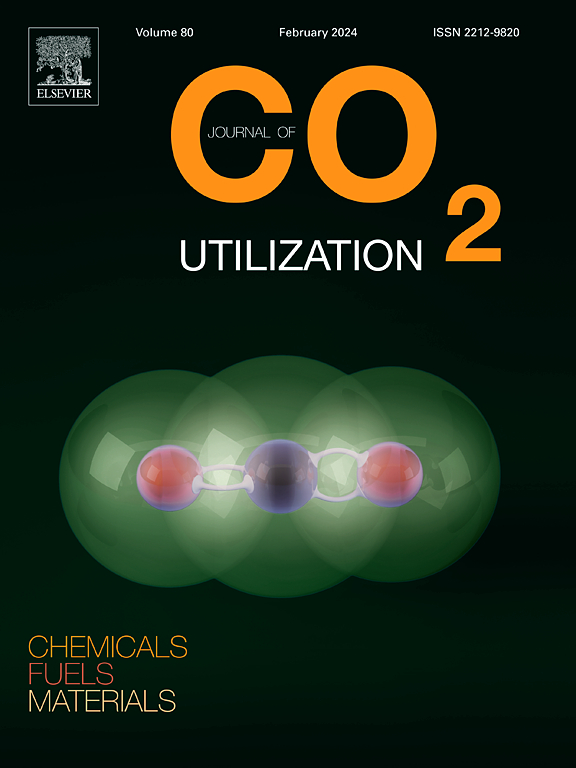Tuning Ru/Ni sites in the perovskite-based precursor synthesis to make more efficient and durable dual-function materials for integrated CO2 capture and methanation
IF 7.2
2区 工程技术
Q1 CHEMISTRY, MULTIDISCIPLINARY
引用次数: 0
Abstract
A new generation of Dual Function Materials (DFMs) were obtained after the controlled reduction of 20 % La0.6Ca0.4Ni0.95Ru0.05O3/CeO2 synthesized combining citric acid-wetness impregnation methods. Different parameters such as pH of the starting solution, calcination protocol were modified in order to synthesize materials with variable nanostructure, surface chemistry and textural properties, thereby effectively tuning the material activity and stability for the integrated CO2 adsorption and in situ methanation operation. The samples were extensively characterized before and after catalytic tests by XRD, Raman, STEM-EDS, XPS, N2 adsorption-desorption, H2-TPR, H2-TPD, CO2-TPD, and H2-TPSR. It was found that the DFM obtained from the precursor prepared in absence of NH3 promoted Ru accommodation within the perovskite structure. The corresponding DFM showed enhanced textural properties, Ru/Ni actives sites accessibility and weak/medium basic sites concentration and, consequently, displayed the highest CH4 yield (312 µmol g−1) and fastest CH4 production kinetics under cycles of CO2 adsorption and in situ hydrogenation to CH4. Furthermore, this sample showed higher stability than conventional Ru-based DFMs, with CH4 production decreasing by less than 6 % compared to 25 % observed for conventional ones, due to a lower tendency for metal sintering, emerging as a promising alternative for long-term operation under realistic industrial conditions.
调整钙钛矿基前驱体合成中的Ru/Ni位点,制备更高效、耐用的双功能材料,用于二氧化碳捕获和甲烷化
采用柠檬酸-湿浸渍法制备了20 % La0.6Ca0.4Ni0.95Ru0.05O3/CeO2可控还原后的新一代双功能材料(DFMs)。通过改变起始溶液的pH、煅烧方案等不同参数,合成了具有不同纳米结构、表面化学和结构性质的材料,从而有效地调节了材料的活性和稳定性,实现了CO2吸附和原位甲烷化操作。通过XRD、Raman、STEM-EDS、XPS、N2吸附-解吸、H2-TPR、H2-TPD、CO2-TPD、H2-TPSR对催化前后的样品进行了广泛的表征。研究发现,在没有NH3的情况下制备的前驱体得到的DFM促进了Ru在钙钛矿结构中的容纳。在CO2吸附和原位加氢生成CH4的循环过程中,DFM具有较高的CH4产率(312µmol g−1)和最快的CH4生成动力学,其结构性能、Ru/Ni活性位点可及性和弱/中等碱性位点浓度均有所提高。此外,该样品比传统的ru基dfs表现出更高的稳定性,由于金属烧结倾向较低,CH4产量下降幅度小于6 %,而传统dfs则为25 %,这是在现实工业条件下长期运行的有希望的替代方案。
本文章由计算机程序翻译,如有差异,请以英文原文为准。
求助全文
约1分钟内获得全文
求助全文
来源期刊

Journal of CO2 Utilization
CHEMISTRY, MULTIDISCIPLINARY-ENGINEERING, CHEMICAL
CiteScore
13.90
自引率
10.40%
发文量
406
审稿时长
2.8 months
期刊介绍:
The Journal of CO2 Utilization offers a single, multi-disciplinary, scholarly platform for the exchange of novel research in the field of CO2 re-use for scientists and engineers in chemicals, fuels and materials.
The emphasis is on the dissemination of leading-edge research from basic science to the development of new processes, technologies and applications.
The Journal of CO2 Utilization publishes original peer-reviewed research papers, reviews, and short communications, including experimental and theoretical work, and analytical models and simulations.
 求助内容:
求助内容: 应助结果提醒方式:
应助结果提醒方式:


